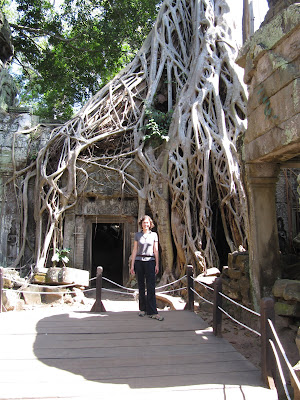














December 4, 2010
On our second day, we arrived at the Angkor Wat temple at 5:20am, before sunrise. My guide and I entered from the rear, walking through sparse jungle with a flashlight. It felt like we were a swat team, doing a rear attack on Angkor Wat. We snuck up the rear stairs and he showed me the famous Angkor Wat bas relief (see above) by flashlight in near-complete darkness. The bas relief depicts the 12 century Cambodian view of Heaven as being filled with near-naked celestial dancers. Hell, on the other hand, was filled with liars having a nail hammered into them, for every lie. And, it included women who did abortions, with a knife put into her stomach as punishment. Then, there was the thorny tree the adulters had to climb, over and over again.
We watched the sun rise, and I took a picture of Angkor Wat with its reflection over the moat. My guide then explained to me how Angkor Wat was designed as the earth, in miniature. The oceans were the moat, the continents were at the base of Mount Meru (some call it "The Olympus of the Hindus") which is said to hold Heaven filled with Hindu gods. There are three levels to the mountain, all of which I climbed. And, as any good Hindu world would have, there was a caste system to who gets to go higher and higher up. The plebians stay at the bottom. The ministers and nobles are at the second level. And, the king and high Hindu priest were the only ones who could go to the top level, the top of Mount Meru, at least until tourist like me line up promptly at 8am to race up to the top of the shrine.
And, it's worth being the first up (I was!). I can see why the king (who saw himself as a heavenly God) and the high priest kept it to themselves. The view was incredible and they were surrounded by ritual baths, they used the sacred water to bathe the Hindu god statues, and they were surrounded by hundreds of statues of topless celestial dancers (note that the statues' breasts were particularly shiny from the regular manhandling they get from tourists). Often, the king disappeared up to the top of Mount Meru, in the shrine, for weeks on end. No one knew what he did up there. They just waited patiently at the second level for him to descend. Me, I was ushered by a guard to descend so more tourists waiting below could ascend.
The "Churning of the Sea of Milk" bas relief was near the end of my Angkor Wat visit, and it's in the pictures above as the demons on one side and the good spirits on the other side, looking as if they are doing tug of war against each other. But, they are actually working as a team to churn the sea of milk. If they churned the sea of milk to a frothy curdle, then they all could be immortal. The hindu god, Vishnu, helped them by reincarnating as a turtle who acted as a base for the churning, and Shiva floated above, adding magical strength to the churners.
As I left the Angkor Wat temple, I walked down the long bridge over the moat and stood next to the snake statues who were said to take Angkor Wat inhabitants on a rainbow bridge connecting earth to the heavens. I felt transported too.
















